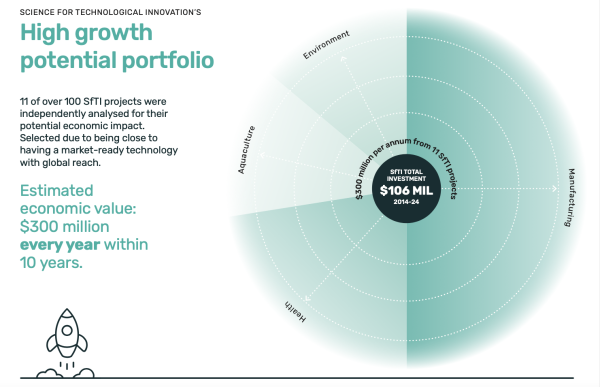SfTI-funded research likely to deliver minimum 300% return on investment
21 June 2024 | Read time: 6 minutes

 Independent review of SfTI projects concludes that the Challenge has created significant economic value
Independent review of SfTI projects concludes that the Challenge has created significant economic value
In SfTI’s ten-year tenure, we have invested $106 million into a portfolio of over 100 research projects, and have supported the work of nearly 700 researchers across Aotearoa New Zealand. Our workshops and training opportunities have helped equip talented scientists with the skills they need to become entrepreneurs. Our events have forged genuine, lasting connections between academics, Māori, industry and end-users. And our programme has transformed the landscape for doing great, high-impact research with equitable outcomes for all.
SfTI has undoubtedly had a significant impact on New Zealand’s science and innovation sector. But what about the economic impact of our work?
To explore that question, we commissioned the New Zealand Institute of Economic Research (NZIER) – an independent, not-for-profit consultancy – to carry out a review of 11 of our projects. The projects chosen represent a diverse range of sectors; from dentistry and eye health, to batteries and surveying robots. Early-stage research is a long way from commercial reality, so in order to value our work as accurately as possible, SfTI selected projects the furthest along that trajectory to impact.
“It is very hard to measure economic impact of early-stage research. There is still so much we don’t know about how SfTI supported technologies could affect lives. But we took everything we do know about this sample portfolio of projects and gave it to the NZIER. They analyzed this information alongside market and industry data and comparative technologies. What they found was extremely rewarding to learn.” Said SfTI’s Commercialisation Manager Deborah Crowe.
“It is very hard to measure economic impact of early-stage research. There is still so much we don’t know about how SfTI supported technologies could affect lives. But we took everything we do know about this sample portfolio of projects and gave it to the NZIER. They analyzed this information alongside market and industry data and comparative technologies. What they found was extremely rewarding to learn.” Said SfTI’s Commercialisation Manager Deborah Crowe.
NZIER used what they describe as a “demand-centric” approach to establish a potential economic value for each project; they looked at the value of the problem being targeted, rather than just the value of the product itself. Their review involved detailed interviews and analysis of project data to understand their goals and to explore their business strategy. NZIER then reviewed relevant markets and their drivers, along with any existing literature on the innovation itself. And finally, they engaged with stakeholders from the relevant sectors to understand specific challenges and possible tensions that might exist.
Based on their analysis of this portfolio of 11 of our projects, NZIER estimates that“the SfTI Challenge’s work will contribute a minimum economic value of over $300 million per annum within 10 years. This is half the size of the ICT sector in New Zealand currently.”

SfTI Director, Professor Sally Davenport says,
“At the close of SfTI, what we see is an innovation system that is primed for success. With new networks and connections creating pathways to impact that didn’t exist a decade ago. We have been extremely proud of the teams and technologies that have emerged from the SfTI community over the years, but we wanted to understand how this new collaborative way of doing science contributes economic value” Said Sally Davenport.
“It was very satisfying to read the review’s conclusions. To see that the projected revenue of just one SfTI-funded technology could pay off our entire initial $106 million investment in 10 years was a very important reminder of the value we’ve added to the New Zealand innovation sector……” she said.
“It was very satisfying to read the review’s conclusions. To see that the projected revenue of just one SfTI-funded technology could pay off our entire initial $106 million investment in 10 years was a very important reminder of the value we’ve added to the New Zealand innovation sector……” said Sally Davenport.
NZIER concluded that SfTI has been effective in targeting markets with higher rates of growth, and has focused on solving big problems, to “ensure that its support would tend to have larger impacts.” In addition, they say that our strategic decision to support a range of technologies, applications, and teams “increases the probability that the portfolio will include successful technological innovations and raises the potential for spill-over impacts from research.”
The review also highlighted our efforts to connect and support researchers to move towards commercialisation, while ensuring they retained the freedom needed to pursue their research. NZIER write that because of this approach, SfTI successfully connected “researchers into market earlier than business-as-usual science, and nurtured continued collaboration between researchers and users of technology.”